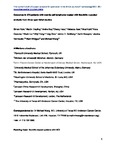Outcomes in 370 patients with mantle cell lymphoma treated with ibrutinib: a pooled analysis from three open-label studies
| dc.contributor.author | Rule, S | |
| dc.contributor.author | Dreyling, M | |
| dc.contributor.author | Goy, A | |
| dc.contributor.author | Hess, G | |
| dc.contributor.author | Auer, R | |
| dc.contributor.author | Kahl, B | |
| dc.contributor.author | Cavazos, N | |
| dc.contributor.author | Liu, B | |
| dc.contributor.author | Yang, S | |
| dc.contributor.author | Clow, F | |
| dc.contributor.author | Goldberg, JD | |
| dc.contributor.author | Beaupre, D | |
| dc.contributor.author | Vermeulen, J | |
| dc.contributor.author | Wildgust, M | |
| dc.contributor.author | Wang, M | |
| dc.date.accessioned | 2017-10-17T11:30:29Z | |
| dc.date.issued | 2017-08-18 | |
| dc.identifier.issn | 0007-1048 | |
| dc.identifier.issn | 1365-2141 | |
| dc.identifier.uri | http://hdl.handle.net/10026.1/10064 | |
| dc.description.abstract |
<jats:title>Summary</jats:title><jats:p>Ibrutinib is highly active in treating mantle cell lymphoma (<jats:styled-content style="fixed-case">MCL</jats:styled-content>), an aggressive B‐cell lymphoma. We pooled data from three ibrutinib studies to explore the impact of baseline patient characteristics on treatment response. Patients with relapsed/refractory <jats:styled-content style="fixed-case">MCL</jats:styled-content> (<jats:italic>n</jats:italic> = 370) treated with ibrutinib had an objective response rate (<jats:styled-content style="fixed-case">ORR</jats:styled-content>) of 66% (20% complete response; 46% partial response); median duration of response (<jats:styled-content style="fixed-case">DOR</jats:styled-content>), progression‐free survival (<jats:styled-content style="fixed-case">PFS</jats:styled-content>) and overall survival (<jats:styled-content style="fixed-case">OS</jats:styled-content>) were 18·6, 12·8 and 25·0 months, respectively. Univariate analyses showed patients with one <jats:italic>versus</jats:italic> >one prior line of therapy had longer <jats:styled-content style="fixed-case">OS</jats:styled-content>. Multivariate analyses identified that one prior line of therapy affected <jats:styled-content style="fixed-case">PFS</jats:styled-content>; Eastern Cooperative Oncology Group (<jats:styled-content style="fixed-case">ECOG</jats:styled-content>) performance status, simplified <jats:styled-content style="fixed-case">MCL</jats:styled-content> international prognostic index (<jats:styled-content style="fixed-case">sMIPI</jats:styled-content>) score, bulky disease, and blastoid histology affected <jats:styled-content style="fixed-case">OS</jats:styled-content> and <jats:styled-content style="fixed-case">PFS</jats:styled-content>. Patients with blastoid <jats:italic>versus</jats:italic> non‐blastoid histology had similar time to best response, but lower <jats:styled-content style="fixed-case">ORR</jats:styled-content>,<jats:styled-content style="fixed-case"> DOR</jats:styled-content>,<jats:styled-content style="fixed-case"> PFS</jats:styled-content> and <jats:styled-content style="fixed-case">OS</jats:styled-content>. <jats:styled-content style="fixed-case">OS</jats:styled-content> and <jats:styled-content style="fixed-case">PFS</jats:styled-content> were longer in patients with better <jats:styled-content style="fixed-case">sMIPI</jats:styled-content>, patients with <jats:styled-content style="fixed-case">ECOG</jats:styled-content> performance status 0–1, non‐bulky disease and non‐blastoid histology. Additionally, the proportion of patients with poor prognostic factors increased with increasing lines of therapy. Together, results suggest that patient outcomes following treatment failure with ibrutinib are related to the natural biological evolution of the disease.</jats:p> | |
| dc.format.extent | 430-438 | |
| dc.format.medium | Print-Electronic | |
| dc.language | en | |
| dc.language.iso | en | |
| dc.publisher | Wiley | |
| dc.subject | ibrutinib | |
| dc.subject | mantle cell lymphoma | |
| dc.subject | pooled analysis | |
| dc.title | Outcomes in 370 patients with mantle cell lymphoma treated with ibrutinib: a pooled analysis from three open-label studies | |
| dc.type | journal-article | |
| dc.type | Article | |
| plymouth.author-url | https://www.ncbi.nlm.nih.gov/pubmed/28832957 | |
| plymouth.issue | 3 | |
| plymouth.volume | 179 | |
| plymouth.publication-status | Published online | |
| plymouth.journal | British Journal of Haematology | |
| dc.identifier.doi | 10.1111/bjh.14870 | |
| plymouth.organisational-group | /Plymouth | |
| plymouth.organisational-group | /Plymouth/Faculty of Health | |
| plymouth.organisational-group | /Plymouth/Faculty of Health/Peninsula Medical School | |
| plymouth.organisational-group | /Plymouth/REF 2021 Researchers by UoA | |
| plymouth.organisational-group | /Plymouth/REF 2021 Researchers by UoA/UoA01 Clinical Medicine | |
| plymouth.organisational-group | /Plymouth/REF 2021 Researchers by UoA/UoA01 Clinical Medicine/UoA01 Clinical Medicine | |
| plymouth.organisational-group | /Plymouth/Research Groups | |
| plymouth.organisational-group | /Plymouth/Research Groups/Institute of Translational and Stratified Medicine (ITSMED) | |
| plymouth.organisational-group | /Plymouth/Research Groups/Institute of Translational and Stratified Medicine (ITSMED)/CBR | |
| plymouth.organisational-group | /Plymouth/Research Groups/Institute of Translational and Stratified Medicine (ITSMED)/CCT&PS | |
| plymouth.organisational-group | /Plymouth/Users by role | |
| plymouth.organisational-group | /Plymouth/Users by role/Academics | |
| dc.publisher.place | England | |
| dcterms.dateAccepted | 2017-06-19 | |
| dc.rights.embargodate | 2018-8-18 | |
| dc.identifier.eissn | 1365-2141 | |
| dc.rights.embargoperiod | Not known | |
| rioxxterms.versionofrecord | 10.1111/bjh.14870 | |
| rioxxterms.licenseref.uri | http://www.rioxx.net/licenses/all-rights-reserved | |
| rioxxterms.licenseref.startdate | 2017-08-18 | |
| rioxxterms.type | Journal Article/Review |


